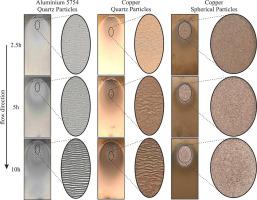Advanced Powder Technology ( IF 5.2 ) Pub Date : 2020-08-19 , DOI: 10.1016/j.apt.2020.07.023 Guilherme Antônio Novelletto Ricardo , Martin Sommerfeld

|
The present research is related to an experimental analysis of the changes in surface roughness of ductile materials exposed to solid particle erosion. Physical data were obtained by an impingement jet facility for erosion times of 2.5, 5 and 10 h and wall inclination angles of 10, 20, 30 and 40°. Aluminium 5754, copper and brass (70%Cu-30%Zn) wall samples were subjected to erosion by quartz sand and spherical glass bead particles with a number mean diameter of 235.4 and 211.5 µm, respectively. Air velocity at the exit of the jet was approximately 26 m/s whilst particle velocity was about 9.5 m/s at the same location. Air velocity measurements (single phase flow) were performed at the exit of the impingement jet by using a one-component laser Doppler anemometer (LDA). To allow measurements of particle motion, a combined method of shadow imaging and particle image velocimetry (PIV) was applied. Particle images were recorded by a double shutter CCD-Camera with macro optics together with background illumination and the particle velocity field was calculated by PIV using a successive refinement of the interrogation area. Global erosion was quantified by weighing the mass of samples before and after each experimental run. Two-dimensional roughness profiles were acquired by optically scanning the surface of each sample after erosion and compared to the initial state of the surface. Changes in the material surface were assessed in the region with most pronounced erosion in terms of three roughness parameters: namely, arithmetic average height (), mean spacing at the mean line () and standard deviation of the roughness angle (). Additionally, insights on the importance of wall roughness on particle behaviour in confined gas–solid flows as well as on modelling particle–wall interaction with rough walls are presented. Regarding the jet flow, results demonstrated the influence of inclination angle on air and particle velocity profiles. The optical measurements showed the influence of solid particle erosion, inclination angle and particle shape on the temporal evolution of surface roughness of the analysed materials. Finally, the experimental data allowed for the development of a simple correlation to estimate the dependency of on solid particle erosion and inclination angle as a function of time.
中文翻译:

固体颗粒腐蚀导致韧性材料表面粗糙度变化的实验评估
本研究与对暴露于固体颗粒侵蚀的易延展材料的表面粗糙度变化进行实验分析有关。物理数据是通过冲击喷射设备获得的,腐蚀时间分别为2.5、5和10小时,壁的倾斜角度为10、20、30和40°。铝5754,铜和黄铜(70%Cu-30%Zn)壁样品分别受到数均直径为235.4和211.5 µm的石英砂和球形玻璃珠颗粒的腐蚀。在同一位置,射流出口处的空气速度约为26 m / s,而粒子速度约为9.5 m / s。使用单组分激光多普勒风速计(LDA)在冲击射流的出口处进行风速测量(单相流)。为了测量粒子运动,结合了阴影成像和粒子图像测速(PIV)的方法。用具有宏观光学特性的双快门CCD相机和背景照明记录颗粒图像,并通过逐次细化询问区域,通过PIV计算颗粒速度场。通过在每次实验之前和之后称量样品的质量来量化整体侵蚀。通过在腐蚀后光学扫描每个样品的表面来获取二维粗糙度轮廓,并将其与表面的初始状态进行比较。根据三个粗糙度参数评估了腐蚀最明显的区域中材料表面的变化:即算术平均高度(用具有宏观光学特性的双快门CCD相机和背景照明记录颗粒图像,并通过逐次细化询问区域,通过PIV计算颗粒速度场。通过在每次实验之前和之后称量样品的质量来量化整体侵蚀。通过在腐蚀后光学扫描每个样品的表面来获取二维粗糙度轮廓,并将其与表面的初始状态进行比较。根据三个粗糙度参数评估了腐蚀最明显的区域中材料表面的变化:即算术平均高度(用具有宏观光学特性的双快门CCD相机和背景照明记录颗粒图像,并通过逐次细化询问区域,通过PIV计算颗粒速度场。通过在每次实验之前和之后称量样品的质量来量化整体侵蚀。通过在腐蚀之后光学扫描每个样品的表面来获取二维粗糙度轮廓,并将其与表面的初始状态进行比较。根据三个粗糙度参数评估了腐蚀最明显的区域中材料表面的变化:即算术平均高度(通过在每次实验之前和之后称量样品的质量来量化整体侵蚀。通过在腐蚀后光学扫描每个样品的表面来获取二维粗糙度轮廓,并将其与表面的初始状态进行比较。根据三个粗糙度参数评估了腐蚀最明显的区域中材料表面的变化:即算术平均高度(通过在每次实验之前和之后称量样品的质量来量化整体侵蚀。通过在腐蚀后光学扫描每个样品的表面来获取二维粗糙度轮廓,并将其与表面的初始状态进行比较。根据三个粗糙度参数评估了腐蚀最明显的区域中材料表面的变化:即算术平均高度(),平均线()和粗糙度角的标准偏差()。此外,还提供了有关壁粗糙度对受限气体-固体流中颗粒行为的重要性以及对颗粒-壁与粗糙壁相互作用的建模的见解。关于射流,结果证明了倾斜角对空气和粒子速度分布的影响。光学测量表明,固体颗粒侵蚀,倾角和颗粒形状对被分析材料表面粗糙度随时间变化的影响。最后,实验数据允许建立一个简单的相关性,以估计 固体颗粒侵蚀和倾斜角随时间变化的关系。



























 京公网安备 11010802027423号
京公网安备 11010802027423号